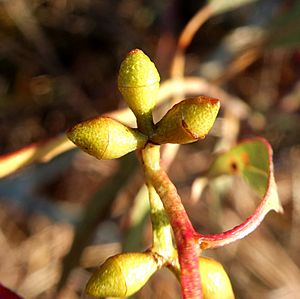Candlebark facts for kids
Quick facts for kids Candlebark |
|
|---|---|
 |
|
| Eucalyptus rubida in Burra, New South Wales | |
| Scientific classification | |
| Genus: |
Eucalyptus
|
| Species: |
rubida
|
Candlebark (also called ribbon gum or white gum) is a special tree found only in southeastern Australia. It is known for its smooth bark, which can sometimes be a bit rough near the bottom. This tree has long, narrow adult leaves, white flowers that grow in groups of three, and fruit shaped like a cup or bell.
Contents
What Candlebark Trees Look Like
Candlebark trees usually grow to be about 20 to 40 meters tall. That's like a 7 to 13-story building! They have a special woody swelling at their base called a lignotuber. This helps the tree regrow if it gets damaged, like from a bushfire.
The bark on these trees is smooth and can be grey, pink, or even look powdery. It peels off in long strips, like ribbons. Sometimes, the bark near the bottom of the trunk can be rough and stringy.
Young Candlebark plants have round leaves that are dull blue-green (this color is called glaucous). These leaves sit directly on the stem without a stalk. As the tree grows, its adult leaves become long and narrow, like the tip of a spear. They are about 8 to 17.5 centimeters long and have a stalk called a petiole.
The tree's flower buds grow in groups of three where the leaves meet the stem (this spot is called an axil). Each group of buds is on a short stalk called a peduncle. The buds themselves are oval-shaped and have a cap, or operculum, on top.
Candlebark trees mostly flower from December to April, and their flowers are white. After the flowers, the tree produces woody fruits. These fruits are shaped like a cup, half-sphere, or bell, and they hold the seeds.
How Candlebark Got Its Name
The Candlebark tree, Eucalyptus rubida, was first officially described in 1899 by two scientists, Henry Deane and Joseph Maiden. They wrote about it in a scientific paper.
The name rubida comes from a Latin word meaning "red." This name was chosen because the tree's bark can turn a reddish color at certain times of the year.
There are actually two slightly different types, or subspecies, of Candlebark:
- Eucalyptus rubida subspecies barbigerorum: This type has young leaves that are oval-shaped. Its trunk has thick, rough bark at the bottom. People sometimes call it "blackbutt candlebark."
- Eucalyptus rubida subspecies rubida: This type has young leaves that are round. Its bark is smooth all the way down to the ground.
Where Candlebark Trees Live
Candlebark trees grow in woodlands and forests. They usually prefer shallow soils found on flat areas, hills, and slopes.
The subspecies barbigerorum is found in the Northern Tablelands of New South Wales, especially north of Armidale.
The subspecies rubida grows in the Southern Tablelands of New South Wales. It's also found mainly on the northern side of the Great Dividing Range in Victoria, between Halls Gap and Delegate. You can also find it on the tablelands and mountain slopes in eastern Tasmania.
Protecting Candlebark Trees
One type of Candlebark, subspecies barbigerorum, is considered "vulnerable." This means it's at risk of becoming endangered if we don't protect it.
The main things that threaten this subspecies are:
- Changes to its natural home because of farming, new buildings, and road construction.
- People collecting timber from where it grows.
It's important to protect these special trees so they can continue to thrive in Australia!
See also
 In Spanish: Corteza de vela para niños
In Spanish: Corteza de vela para niños


